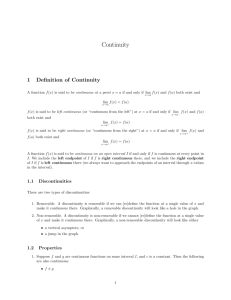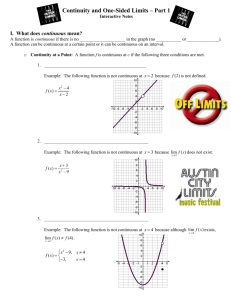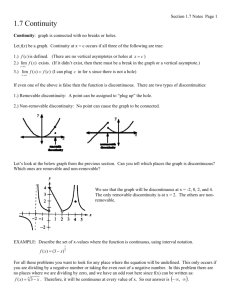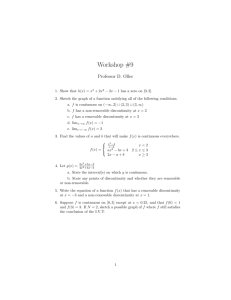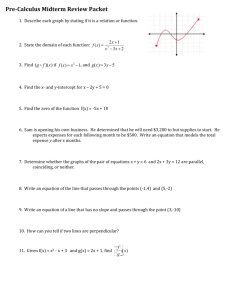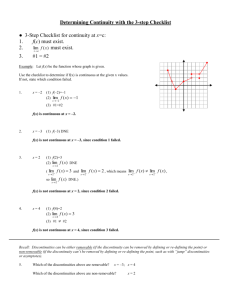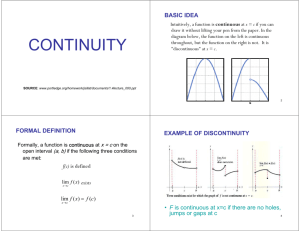PreCalculus Fall 2012 Lesson 092 _Finding the discontinuities of a
advertisement
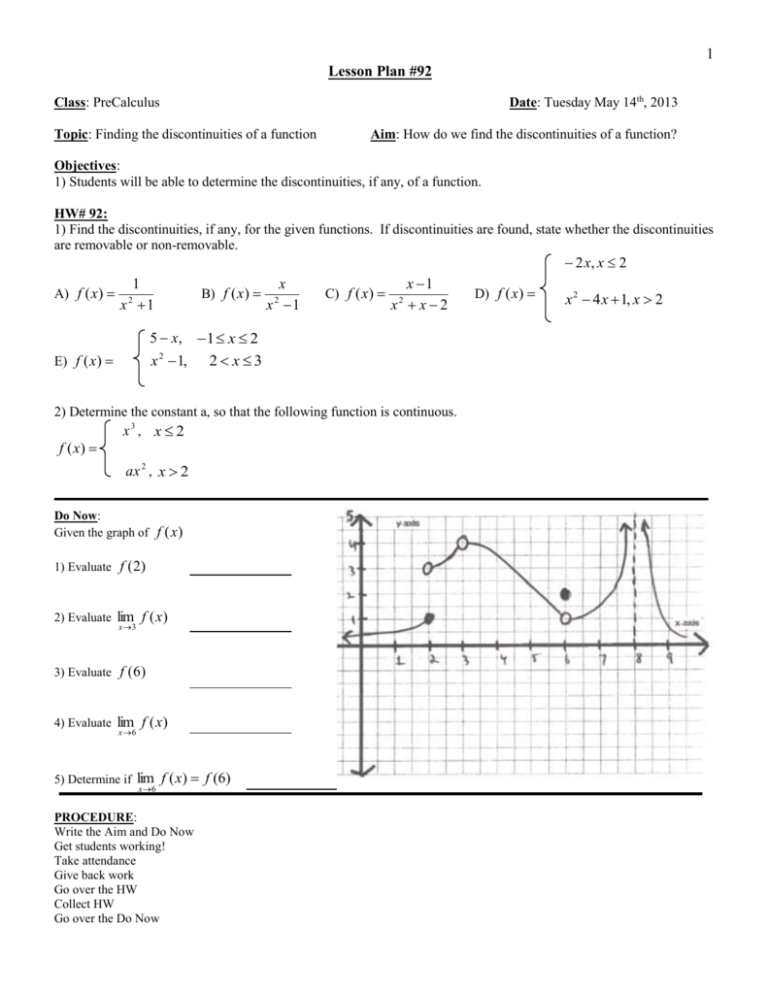
1 Lesson Plan #92 Date: Tuesday May 14th, 2013 Class: PreCalculus Topic: Finding the discontinuities of a function Aim: How do we find the discontinuities of a function? Objectives: 1) Students will be able to determine the discontinuities, if any, of a function. HW# 92: 1) Find the discontinuities, if any, for the given functions. If discontinuities are found, state whether the discontinuities are removable or non-removable. 2 x, x 2 A) f ( x) 1 x 1 B) f ( x) 2 x x 1 2 C) f ( x) x 1 x x2 2 1 x 2 x 1, 2 x 3 5 x, E) f (x ) 2 2) Determine the constant a, so that the following function is continuous. x3 , x 2 f (x) ax 2 , x 2 Do Now: Given the graph of f (x ) 1) Evaluate f ( 2) 2) Evaluate lim f ( x ) x3 3) Evaluate f (6) 4) Evaluate lim f ( x ) x 6 5) Determine if lim f ( x) f (6) x 6 PROCEDURE: Write the Aim and Do Now Get students working! Take attendance Give back work Go over the HW Collect HW Go over the Do Now D) f (x ) x 2 4 x 1, x 2 2 Suppose someone says that a function is continuous (in particular, continuous at x = c), what does that mean? What are some things that can disrupt the continuity of a function (Hint, refer to the Do Now)? Definition of Continuity: Continuity at a Point – A function f is said to be continuous at c if the following three conditions are met. 1) f (c ) is defined 2) lim f ( x ) exists 3) lim f ( x) f (c) x c x c Continuity on an Open Interval – A function is said to be continuous on an interval (a, b) if it is continuous at each point in the interval. In laymen’s terms, if a function is continuous over an interval, we can draw its graph without lifting pencil from paper. The graph has no holes, breaks, or jumps on the interval. Discontinuities fall into 2 categories; removable and non-removable. A removable discontinuity occurs when the limit, at the point of discontinuity, exists from both sides of the point of discontinuity. A non-removable discontinuity occurs when the limit, at the point of discontinuity, does not exist. A jump discontinuity occurs when the limit exists from the left and from the right, but the limits are different. Looking at the figure in the Do Now, for which values of x is the function discontinuous? Which of those values are removable discontinuities? __________________ Non-removable discontinuities? _______________ Where do you have jump discontinuities? Suppose you have the function f ( x ) x 3 , we would have two discontinuities; one at x 3 and one at x 3 , due to the x2 9 fact that both of these values would make the function undefined. But also notice the function can be redefined by canceling out 1 . This would show that the discontinuity at x 3 is removable, x3 since it doesn’t make the redefined function undefined. But x 3 is a non-removable discontinuity because even the redefined function is discontinuous at x 3 . The type of discontinuity that occurs at a vertical asymptote is called an infinite the x 3 factor, giving us the redefined function f ( x) discontinuity. Examples or Exercises: 1) Find the points of discontinuity if any A) f ( x) x3 2 3 f ( x) x 1 x 1 C) f ( x) 1 x 4 B) 2 2 2) Find the discontinuities, if any for the given functions. Which discontinuities are removable? A) B) f ( x) f ( x) x 2 2 x 1 x , x 1 x2 , x 1 D) f (x ) x x 1 C) f ( x) 2 3 x, x 2 x 2 1, E) f (x ) x2 2) Determine the constants a and b so that the following function is continuous 2 , x 1 ax b , 1 x 3 2, x3 f (x) 3) Is the function f ( x) 1 x 2 continuous at x 1 ? Give your reason for the answer Sample Test Questions: x2 1 , if x 1 x 1 1) Let f (x ) 4, if x 1 Which of the following statements are true? I. lim f ( x ) exists II. f (1) exists x1 A) I only B) II only C) I and II only III. f is continuous at D) none of them E) all of them x 1 x2 x 3x 10 2 4 2) lim x 0 x is x A) 1 C) B) 0 D)-1 E) limit does not exist x3 8 3) lim 2 x 0 x 4 x2 x x 4) Let f (x ) if 1 x0 x0 If Which of the following statements is (are) true? I. f (0) exists II. lim f ( x ) exists III. f is continuous at x 0 A) I only 5) If B) II only C) I and II only D) all of them 1 2 E) none of them x is the greatest integer not greater than x, then lim1 x is x A) x0 B) 1 C) non existent D) 0 2 E) None of the other choices Questions 6-9 are based on the function f shown in the graph and defined below 6. lim f ( x ) x 2 A) equals 0 B) equals 1 C) equals 2 D) does not exist E) None of the other choices 7. The function f has a removable discontinuity at A) x0 B) x 1 C) x2 D) x3 C) 1 x 2 D) x3 E) none of these 8) On which interval is f continuous A) 1 x 0 B) 0 x 1 D) 2 x3 E) None of the other choices 9) The function f has a jump discontinuity at A) x 1 B) x 1 C) x2 E) None of the other choices
